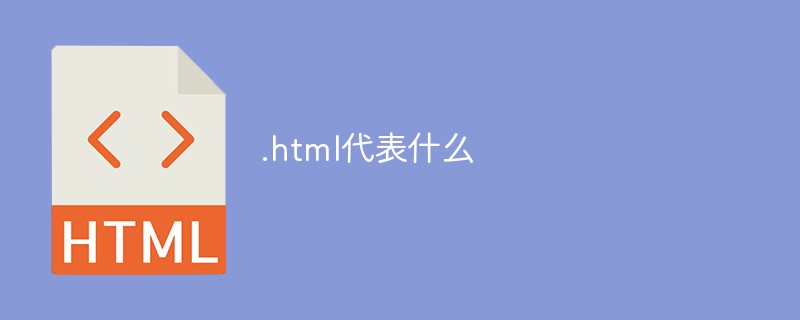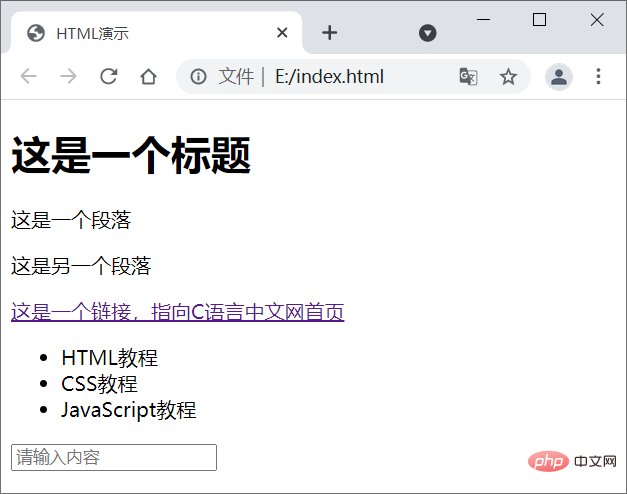What does .html stand for?
".html" stands for HTML document, which refers to a file written in HTML language. It can be read by a variety of web browsers to generate web pages that transmit various types of information; it is a pure text file. , which can be opened or created using text editors such as Windows Notepad, Sublime Text, and VSCode.

The operating environment of this tutorial: Windows 7 system, HTML5 version, Dell G3 computer.
".html" represents an HTML document and refers to a file written in HTML language. (The suffix of HTML documents is generally .html. You can also use .htm, but it is rare.)
HTML documents are plain text files. You can Use text editors such as Windows Notepad, Linux Vim, Notepad, Sublime Text, VS Code, etc. to open or create.
Each web page is an HTML document. Using a browser to access a link (URL) is actually the process of downloading, parsing and displaying the HTML document. Putting many HTML documents in a folder and providing external access creates a website.
HTML files are files that can be read by a variety of web browsers to generate web pages that convey various types of information. In essence, the Internet is a collection of transmission protocols and various types of documents, of which HTML files are just one. These HTML files are stored on server hard drives distributed around the world. Through the transmission protocol, users can remotely obtain the information and information conveyed by these files.
HTML document structure
The basic structure of the HTML page is as follows, which contains various tags required to create web pages (such as doctype , html, head, title and body, etc.).
<!DOCTYPE html>
<html>
<head>
<meta charset="UTF-8">
<title>HTML演示</title>
</head>
<body>
<h1 id="这是一个标题">这是一个标题</h1>
<p>这是一个段落</p>
<p>这是另一个段落</p>
<a href="http://c.biancheng.net/" target="_blank">这是一个链接,指向C语言中文网首页</a>
<ul>
<li>HTML教程</li>
<li>CSS教程</li>
<li>JavaScript教程</li>
</ul>
<input type="text" placeholder="请输入内容" />
</body>
</html>The syntax is as follows:
- ##: This is a document type declaration, used to declare the document as an HTML document (technically it not a tag), the doctype declaration is not case-sensitive;
- : This tag is the root tag of the HTML page, and all other tags need to be in Definition between and tags; ## : This tag is used to define some information of the HTML document, such as Title, encoding format, etc.;
- : used to indicate that the current web page uses UTF-8 encoding, and UTF-8 is universal Encoding format, most web pages use UTF-8 encoding;
- : This tag is used to define all the content in the web page that we can see through the browser, such as paragraphs and titles. , pictures, links, etc.;
- : This tag is used to define a paragraph;
- ## : This tag is used to define a link;
-
- : This tag is used to define a list List item;
- : used to define an input box.
- Since HTML documents are text files, we can use any text editor to create and modify HTML files. For beginners, it is best to use the text editor that comes with the system. For example, Windows Notepad, Linux Vim and Mac OS TextEdit. After you have a certain foundation, you can then choose a professional text editor, such as Notepad, Sublime Text, VS Code, etc.
: This tag is used to define the title;
.html
or.htm format before you can open it directly in the browser and browse the content. For example, save the above sample code in a file named index.html. Double-click it to see the running results in the browser, as shown below:
Recommended tutorial: " html video tutorial
html video tutorial
The above is the detailed content of What does .html stand for?. For more information, please follow other related articles on the PHP Chinese website!

Hot AI Tools

Undresser.AI Undress
AI-powered app for creating realistic nude photos

AI Clothes Remover
Online AI tool for removing clothes from photos.

Undress AI Tool
Undress images for free

Clothoff.io
AI clothes remover

AI Hentai Generator
Generate AI Hentai for free.

Hot Article

Hot Tools

Notepad++7.3.1
Easy-to-use and free code editor

SublimeText3 Chinese version
Chinese version, very easy to use

Zend Studio 13.0.1
Powerful PHP integrated development environment

Dreamweaver CS6
Visual web development tools

SublimeText3 Mac version
God-level code editing software (SublimeText3)

Hot Topics
 What is useEffect? How do you use it to perform side effects?
Mar 19, 2025 pm 03:58 PM
What is useEffect? How do you use it to perform side effects?
Mar 19, 2025 pm 03:58 PM
The article discusses useEffect in React, a hook for managing side effects like data fetching and DOM manipulation in functional components. It explains usage, common side effects, and cleanup to prevent issues like memory leaks.
 Explain the concept of lazy loading.
Mar 13, 2025 pm 07:47 PM
Explain the concept of lazy loading.
Mar 13, 2025 pm 07:47 PM
Lazy loading delays loading of content until needed, improving web performance and user experience by reducing initial load times and server load.
 What are higher-order functions in JavaScript, and how can they be used to write more concise and reusable code?
Mar 18, 2025 pm 01:44 PM
What are higher-order functions in JavaScript, and how can they be used to write more concise and reusable code?
Mar 18, 2025 pm 01:44 PM
Higher-order functions in JavaScript enhance code conciseness, reusability, modularity, and performance through abstraction, common patterns, and optimization techniques.
 How does currying work in JavaScript, and what are its benefits?
Mar 18, 2025 pm 01:45 PM
How does currying work in JavaScript, and what are its benefits?
Mar 18, 2025 pm 01:45 PM
The article discusses currying in JavaScript, a technique transforming multi-argument functions into single-argument function sequences. It explores currying's implementation, benefits like partial application, and practical uses, enhancing code read
 How does the React reconciliation algorithm work?
Mar 18, 2025 pm 01:58 PM
How does the React reconciliation algorithm work?
Mar 18, 2025 pm 01:58 PM
The article explains React's reconciliation algorithm, which efficiently updates the DOM by comparing Virtual DOM trees. It discusses performance benefits, optimization techniques, and impacts on user experience.Character count: 159
 What is useContext? How do you use it to share state between components?
Mar 19, 2025 pm 03:59 PM
What is useContext? How do you use it to share state between components?
Mar 19, 2025 pm 03:59 PM
The article explains useContext in React, which simplifies state management by avoiding prop drilling. It discusses benefits like centralized state and performance improvements through reduced re-renders.
 How do you prevent default behavior in event handlers?
Mar 19, 2025 pm 04:10 PM
How do you prevent default behavior in event handlers?
Mar 19, 2025 pm 04:10 PM
Article discusses preventing default behavior in event handlers using preventDefault() method, its benefits like enhanced user experience, and potential issues like accessibility concerns.
 What are the advantages and disadvantages of controlled and uncontrolled components?
Mar 19, 2025 pm 04:16 PM
What are the advantages and disadvantages of controlled and uncontrolled components?
Mar 19, 2025 pm 04:16 PM
The article discusses the advantages and disadvantages of controlled and uncontrolled components in React, focusing on aspects like predictability, performance, and use cases. It advises on factors to consider when choosing between them.






